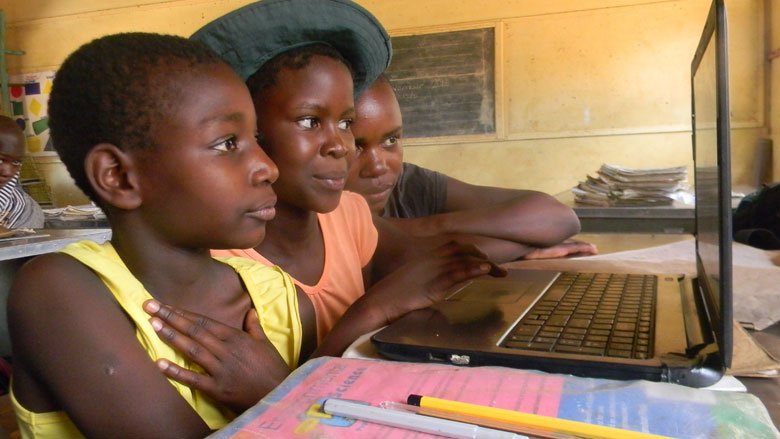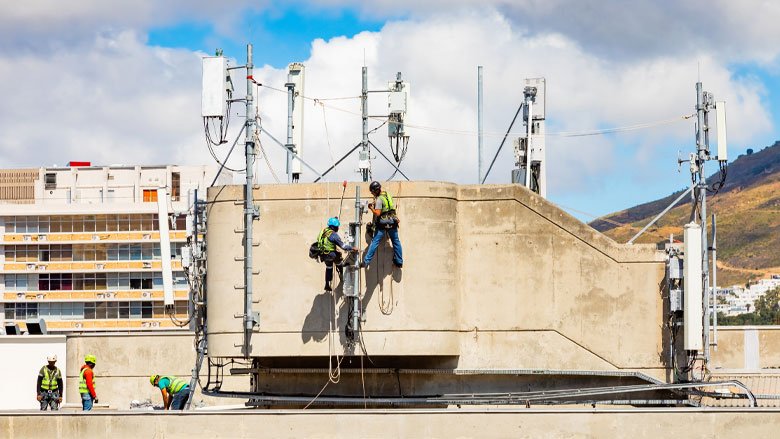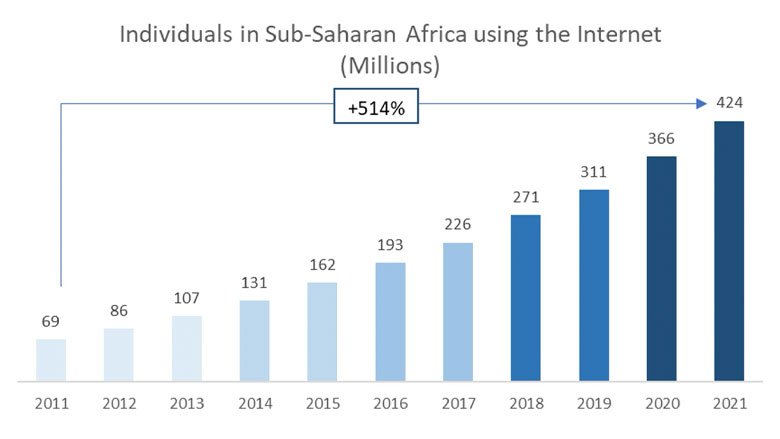
CHALLENGE
Accessible, Affordable, and Inclusive Broadband
The availability and use of digital technologies are strongly linked to economic growth, innovation, job creation, and inclusion, at both the national and regional levels. Sub-Saharan Africa, however, still faces significant challenges in digital development.
- The region’s digital infrastructure coverage, access, and quality still lag other regions. At the end of 2021, while 84 percent of people in SSA lived in areas where 3G service was available, and 63 percent had access to 4G mobile coverage, only 22 percent were using mobile internet services. The gap between coverage and usage is similarly large for broadband, with 61 percent of people in sub-Saharan Africa living within broadband range but not using it.
- Affordability of mobile connectivity, measured by the price of one gigabyte (GB) of mobile data, is another major constraint. In 2019, the average cost of one GB of mobile internet as a percentage of monthly per-capita Gross National Income (GNI) was 10.5 percent, which is considerably higher than the 2 percent target recommended by the United Nations Broadband Commission. In addition, in 2021, the median cost of an entry-level internet-enabled handset amounted to more than 25.2 percent of monthly gross domestic product per capita.
- The region has one of the widest digital gender gaps globally. The greatest disparity exists for internet use, where women are 37 percent less likely than men to use mobile internet according to 2023 GSMA data.
- In 2021, around 470 million people in Sub-Saharan Africa did not have proof of ID, preventing them from fully benefiting from critical public and some private services.
“The minimal usage of mobile internet is a lost opportunity for inclusive growth in Africa,” says Andrew Dabalen, World Bank Chief Economist for Africa. “Closing the uptake gap would increase the continent’s potential to create jobs for its growing population and boost economic recovery in a highly digitalized world.”
APPROACH
A Strategic Framework for Digital Transformation
The World Bank, together with other development partners and sector stakeholders, is supporting the region in achieving its digital transformation. Within the International Development Association (IDA), technology is a cross-cutting theme covering three areas of work: i) closing the digital connectivity gap; ii) investing in safe and open digital public infrastructure (DPI); and iii) helping countries access and use digital services, particularly in the context of the jobs and economic transformation agenda.
A range of World Bank projects have contributed to a 115 percent increase in the number of internet users in Sub-Saharan Africa, from 19 percent in 2016 to 36 percent in 2021. The World Bank’s flagship Digital Economy for Africa (DE4A) initiative supports the ambition of ensuring that every individual, business, and government in Africa is digitally enabled by 2030. Under the DE4A initiative, the World Bank has delivered 70 digitalization projects in Africa since 2019, aiming to build the foundation for a vibrant, safe, resilient, and inclusive digital economy totaling $9 billionacross 37 countries.
Increased accessibility of broadband services, accompanied by enhanced affordability and service quality, leads to higher inclusion. Digital inclusion, in turn, has a positive impact on creating jobs and reducing poverty. In 2023, a World Bank flagship report found that in Nigeria and Tanzania, extreme poverty declined by about 7 percent after three or more years of exposure to internet coverage, while labor force participation and wage employment increased by up to 8 percent.
Achieving a vibrant, inclusive, and secure digital economy requires more than basic access to the internet. It necessitates a comprehensive approach that considers the entire digital ecosystem, integrating additional foundational elements to complement infrastructure. While the availability of internet or broadband access is an important first step in getting people online, DPI represents the foundational guiderails for digital transactions among people, businesses, and governments to make them more inclusive, efficient, and innovative. Open standards and interfaces allow DPI to drive innovation in the public and private sectors, while digital identification and authentication of people, and the capability for seamless digital transactions, are prerequisites for a holistic and comprehensive digital transformation.
A thriving digital economy, moreover, needs more than infrastructure alone. It also depends on the presence of a sizable and skilled tech-savvy workforce that can build on digital advancements to drive innovation and productivity, creating a dynamic ecosystem that enables businesses to enter the digital realm and scale up successfully. Once these essential foundations are firmly established, a wide range of transformative use-cases emerge, primarily driven by the private sector.

RESULTS
Increasing Affordable, Inclusive Connectivity
Between 2016 and 2021, Western and Central Africa has witnessed a noticeable increase in the number of internet users, from 23 to 47 percent, while the percentage of people using the internet in Eastern and Southern Africa increased from 16 to 27 percent. Coastal and island states including Liberia, Sierra Leone, Senegal, Côte d’Ivoire, Djibouti, Comoros, Mauritania, and Togo gained access to new submarine internet cables, helping to increase available capacity and raising the average broadband download speed on the continent from 2.68 megabytes per second (Mbps) in 2019 to 8.31 Mbps in 2022. This improvement in speed allows the user experience to move from basic Web surfing to accessing a variety of productive content (such as online learning and basic services).
Connection affordability has also improved significantly and rapidly in sub-Saharan Africa, with costs decreasing on average from 11.5 percent of monthly gross national income (GNI) per capita in 2019 to 5.7 percent in 2021. These advances are particularly noteworthy in Benin (where this figure fell from 20 percent to 3 percent) and Somalia(from 18 percent to 2 percent). In Niger, the Smart Villages for Rural Growth and Digital Inclusion Project helped reduce the retail price of 1GB per month by 71 percent between 2019 and 2022.
The World Bank has also supported countries such as Angola, Ethiopia, and Senegal in implementing reformsaimed at enhancing competition and better management of public telecom assets, and helped countries such as Mauritania, the Democratic Republic of Congo, and Cabo Verde to open the internet wholesale and retail markets to competition.
Digital inclusion is benefiting women and girls, as well as populations in underserved areas, in many African countries. For example, in Uganda, a 2021 World Bank collaboration with the EQUALS Global Partnership’s Access Coalition, GSMA, Trickle Up, and AVSI launched a women’s digital literacy and inclusion pilot among refugee and host community participants. Participants reported a fourfold increase in basic digital skills. Over 90 percent of women reported having ownership and control of digital devices, as well as new or improved income-generating and/or employment opportunities. In Ethiopia, over 900,000 poor households in drought-prone communities received their benefits in electronic accounts in 2023, 43 percent of which are owned and operated by women. In Mozambique, theSocial Protection and Economic Resilience Project increased the number of families with children in the poorest districts that received social protection transfers through digital payments 121-fold between 2021 and 2022.
“For us who live far from the city, mobile transfers helped us a lot, especially in the time of COVID-19 confinements. Because before then, when we needed products, we had to travel to go to the supplier. But now, I call, order the product, transfer the money, and they deliver it here.” – Maria Djata, a trader from Guinea-Bissau who is leveraging digital technology to improve her business.
Expanding Broadband in Mauritania Mauritania had limited access to international connectivity, and the cost of internet services was high and of low quality. The West Africa Regional Communications Infrastructure Program (WARCIP) provided $330 million in IDA credit and grants, seeking to increase the geographical reach of broadband networks and reduce the cost of communications services in West Africa. In December 2012, when WARCIP’s implementation began in Mauritania, the mobile broadband penetration rate stood at 3 percent. By 2021-2022, the project had contributed to extending connectivity to previously underserved or unserved areas through the deployment of 1,700 km of fiber optic cable. Access and affordability increased significantly, with a 53 percent increase in localities connected to broadband, and a 99 percent reduction in the average wholesale broadband price, from $7,000/month to $55/month. The case of Mauritania illustrates a trend across the West Africa region, where the volume of available internationalinternet bandwidth increased 9-fold between 2011 and 2017, and the retail price of internet services decreased by 81 percent. |
DATA HIGHLIGHTS

PARTNERSHIPS
Joining Efforts for a Regional Digital Market
The World Bank is stepping up support for digital transformation in Africa in collaboration with several partners, such as the African Union Commission (AUC), the African Development Bank (AfDB), the GSMA, the United Nations, and donor governments. The DE4A initiative, for example, contributes to the operationalization of the African Union’s Digital Transformation Strategy for Africa, which was developed with support from the World Bank. The strategy highlights the key policy reforms and investments needed at the national and regional level for the continent to achieve its digital development ambitions. As such, the World Bank supports national, regional, and continental efforts for high-level policy and regulatory harmonization, cooperation, and coordination between countries within the regional economic communities (RECs), as well as between RECs and the AUC at the continental level to achieve the continent’s digital development ambitions. Other partnerships with local and regional organizations, as well as with the private sector, are key to achieving long-lasting impact on digital development. The Smart Africa Alliance, an innovative commitment from African heads of state and government, has grown its membership from seven countries in 2013 to 31 countries in 2020 and, with the World Bank, supports its member countries to “usher Africa into the knowledge economy era through smart use and leveraging of Information and Communication Technologies (ICTs).”
LOOKING AHEAD
A People-centered Technological Transformation
Digital investments and reforms are being scaled up significantly and will support African countries in accelerating their digital transformation. The three main priorities moving forward are:
- Accelerating affordable broadband for all by closing the access gap through sector reforms and catalytic investments in connecting rural/remote areas, schools, clinics, and community centers, and addressing the usage and inclusion gaps to include affordability, devices, gender and inclusion, and digital literacy.
- Scaling up inclusive and safe DPI through investments in digital ID, payment systems, and data sharing; strengthening trust and resilience through improved cloud services, data protection, and cybersecurity; and facilitating high-impact digital services (e.g., financial services, tax declaration, agriculture, e-health, and cash transfers)
- Building in-demand digital job skills for digitally enabled industries and developing local information technology industry, content, and support services.
The World Bank is actively supporting digitalization initiatives in Sub-Saharan Africa, using both existing and future digital infrastructure to ensure that digital technologies better meet the needs of people, households, and firms, and strengthening a virtuous cycle of technology-led transformation.
Source link
Digital Transformation Drives Development in Africa #Digital #Transformation #Drives #Development #Africa
Source link Google News
Source Link: https://projects.worldbank.org/en/results/2024/01/18/digital-transformation-drives-development-in-afe-afw-africa